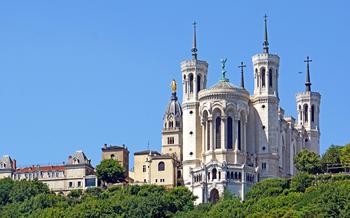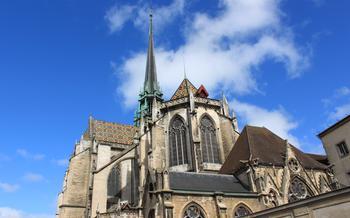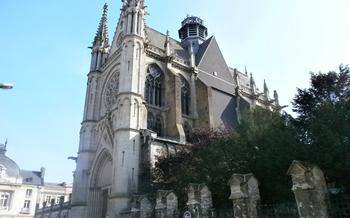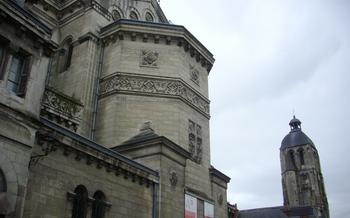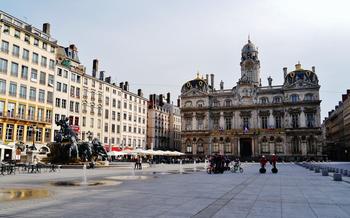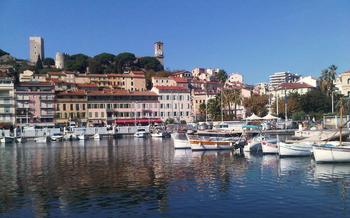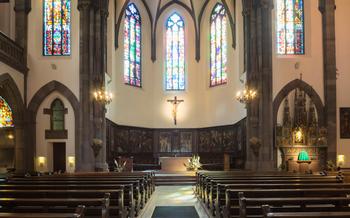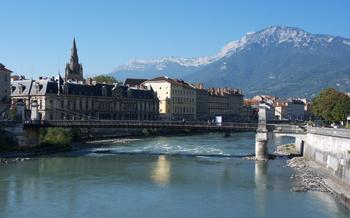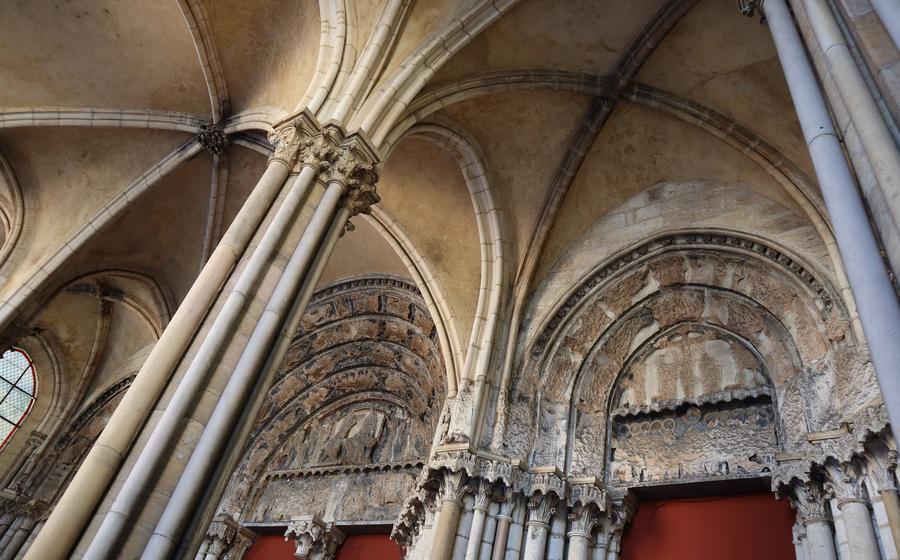
Église Notre Dame de Dijon
- Église Notre Dame de Dijon: A Journey Through History
- Architectural Marvel
- Interior Splendor
- Notre Dame de Dijon's Sculptures
- Stained Glass Masterpieces
- Astronomical Clock
- Crypts and Archaeological Discoveries
- Guided Tours and Workshops:
- Concerts and Events
- Pilgrimage Site
- Visiting Tips:
- Photography and Videography:
- Accessibility
- Local Festivals and Celebrations
- Insider Tip:
Église Notre Dame de Dijon: A Journey Through History
Nestled in the heart of Dijon, France, the Église Notre Dame de Dijon stands as a testament to the city's rich architectural and religious heritage. Its history dates back to the 13th century when the original Romanesque church was replaced by a Gothic masterpiece. Over the centuries, the church has undergone numerous modifications and additions, reflecting the evolving architectural styles and tastes of its time.
The church's construction began in the early 13th century under the patronage of Duke Odo III of Burgundy. The initial design was inspired by the Gothic style that was gaining popularity in France at the time. However, as construction progressed, influences from the Flamboyant Gothic style began to emerge, resulting in a harmonious blend of architectural elements from different periods.
Throughout its history, the Église Notre Dame de Dijon has witnessed significant events and been associated with notable figures. It served as the burial place for several Dukes of Burgundy, including Philip the Bold and John the Fearless. The church also played a crucial role during the French Revolution, when it was transformed into a Temple of Reason.
Key historical milestones associated with the church include its consecration in 1237, the addition of the Flamboyant Gothic choir in the 15th century, and its designation as a UNESCO World Heritage Site in 20These milestones reflect the enduring significance of the Église Notre Dame de Dijon as a symbol of faith, history, and architectural achievement.
Architectural Marvel
The Église Notre Dame de Dijon stands as a testament to the grandeur and artistry of Gothic architecture. Its soaring spires and intricate facade are a sight to behold, inviting visitors to step back in time and marvel at the skill and devotion of medieval builders.
The church's exterior is adorned with a wealth of sculptures and carvings, each one telling a story from the Bible or the lives of the saints. Gargoyles and grotesque figures peer out from the roofline, adding a touch of whimsy and mystery to the building's otherwise solemn appearance.
Inside, the church is equally impressive, with its vast dimensions and soaring vaults creating a sense of awe and wonder. The intricate stained glass windows bathe the interior in a kaleidoscope of colors, casting a warm glow on the polished stone floors and ornate altars.
The church's architecture is a blend of different Gothic styles, reflecting the evolution of the style over time. The nave, with its pointed arches and ribbed vaults, is an example of early Gothic, while the choir, with its more elaborate decoration and flamboyant tracery, represents the later Gothic period.
The Église Notre Dame de Dijon is a masterpiece of Gothic architecture, and its beauty and grandeur continue to inspire visitors from around the world.
Interior Splendor
The interior of the Église Notre Dame de Dijon is a testament to the grandeur and artistry of Gothic architecture. As you step inside, you are greeted by a sense of awe and wonder, dwarfed by the towering vaults that rise above you. The vast dimensions of the nave create a feeling of spaciousness, while the intricate artwork that adorns every surface draws the eye in every direction.
The walls of the church are adorned with a dazzling array of paintings, sculptures, and tapestries, each telling a story from the Bible or the lives of the saints. The stained glass windows, with their vibrant colors and intricate designs, cast a warm glow on the interior, creating an ethereal atmosphere.
Of particular note is the church's collection of reliquaries, which contain the remains of various saints and martyrs. These ornate containers, often made of gold and silver, are a testament to the devotion and reverence with which the church has been held throughout the centuries.
To fully appreciate the beauty and significance of the church's interior, it is recommended to take a guided tour. Expert guides will lead you through the church, explaining the history, symbolism, and artistic value of the various artworks and architectural features. They will also point out hidden details that you might otherwise miss, such as the subtle interplay of light and shadow on the sculptures or the intricate carvings on the choir stalls.
Whether you choose to explore the church on your own or with a guide, the interior of the Église Notre Dame de Dijon is sure to leave a lasting impression. It is a place where art, history, and spirituality come together to create a truly awe-inspiring experience.
Notre Dame de Dijon's Sculptures
The Église Notre Dame de Dijon is home to an extraordinary collection of sculptures, which are considered among the finest examples of medieval art in France. These sculptures, created by talented artisans over several centuries, adorn the church's interior and exterior, adding to its rich visual tapestry.
One of the most striking sculptures is the "Crucifixion" group, located in the north transept. This poignant depiction of Christ on the cross, flanked by the Virgin Mary and Saint John the Evangelist, showcases the emotional intensity and narrative power of medieval sculpture. The expressiveness of the figures, captured in intricate detail, conveys the profound grief and anguish of the crucifixion scene.
Another notable sculpture is the "Virgin and Child", situated in the south transept. This tender representation of the Madonna holding the infant Jesus exudes a sense of warmth and intimacy. The delicate features of the Virgin Mary and the playful expression on the child's face reveal the sculptor's mastery in capturing human emotions and relationships.
The church also boasts a series of gargoyles and grotesques, which serve both a functional and decorative purpose. These fantastical creatures, often depicted with grimacing expressions and contorted limbs, were designed to drain rainwater from the roof while adding a touch of whimsy and mystery to the church's exterior.
The sculptures of the Église Notre Dame de Dijon stand as a testament to the skill and artistry of medieval craftsmen. They invite visitors to contemplate the religious, historical, and cultural significance of these artworks, which have stood the test of time and continue to inspire awe and admiration.
Stained Glass Masterpieces
The Église Notre Dame de Dijon is renowned for its exquisite stained glass windows, which transform the interior of the church into a kaleidoscope of vibrant colors and intricate designs. These magnificent windows, dating from the 13th to the 16th centuries, depict a vast array of biblical scenes, saints' lives, and historical events.
The iconography and symbolism embedded within the stained glass windows are deeply rooted in Christian theology and medieval culture. The windows serve as a visual narrative, guiding the faithful through stories of salvation, redemption, and the lives of saints who exemplified Christian virtues.
The techniques used to create these stained glass masterpieces are a testament to the skill and artistry of medieval craftsmen. The windows are composed of individual pieces of colored glass, meticulously cut and arranged to form intricate patterns and figures. The use of lead came and grisaille, a type of paint applied to the glass, adds depth and detail to the designs.
The stained glass windows of the Église Notre Dame de Dijon are not merely decorative elements; they are an integral part of the church's spiritual and artistic heritage. They serve as a reminder of the power of light to transform and inspire, and their beauty continues to awe and captivate visitors to this day.
Compared to other Gothic cathedrals in France, the stained glass windows of the Église Notre Dame de Dijon stand out for their exceptional quality and preservation. While many cathedrals have suffered damage or loss of their original windows over time, the Église Notre Dame de Dijon has managed to retain a significant portion of its medieval stained glass. This makes the church a particularly valuable site for studying and appreciating the art of stained glass in the Gothic period.
Astronomical Clock
Within the sacred confines of the Église Notre Dame de Dijon, a marvel of medieval engineering awaits discovery—the astronomical clock. This intricate masterpiece, a testament to human ingenuity, stands as a symbol of the church's rich history and enduring legacy.
Crafted with meticulous precision, the clock's complex mechanisms and gears work in perfect harmony to display not only the time but also astronomical information and a captivating array of moving figures. As the hours pass, celestial bodies dance across the clock's face, while intricate automata enact scenes from biblical narratives and historical events.
The clock's origins can be traced back to the 14th century, when it was first conceived as a means of educating and entertaining the faithful. Over the centuries, it has undergone several modifications and restorations, each contributing to its enduring fascination. Today, it stands as a testament to the skill and dedication of its creators, a reminder of the ingenuity that characterized the medieval era.
Visitors to the church are often mesmerized by the clock's intricate details and the precision of its movements. It is a true work of art, a testament to the creativity and technical prowess of its makers. The astronomical clock is a must-see for anyone interested in history, science, or simply marveling at the wonders of human ingenuity.
Crypts and Archaeological Discoveries
Beneath the grand exterior of the Église Notre Dame de Dijon lies a hidden world of crypts and archaeological treasures. Descend into the dimly lit, stone-vaulted chambers and step back in time to explore the lives of past generations. The crypts offer a glimpse into the church's early history and the rich heritage of the region.
Archaeological excavations conducted in the crypts have uncovered a wealth of artifacts and remains, shedding light on the church's origins and evolution. Discover ancient tombs, intricate carvings, and fragments of pottery that tell stories of faith, devotion, and daily life in medieval Dijon.
The atmosphere in the crypts is both eerie and awe-inspiring. The low ceilings, rough-hewn walls, and flickering candlelight create a sense of mystery and wonder. As you wander through the chambers, you can almost hear the echoes of footsteps from centuries past.
Don't miss the opportunity to explore the crypts of the Église Notre Dame de Dijon. They offer a unique and fascinating perspective on the church's history and the lives of those who came before us.
Guided Tours and Workshops:
Enhance your visit to the Église Notre Dame de Dijon by taking advantage of the guided tours offered by the church. Led by knowledgeable guides, these tours provide an in-depth exploration of the church's history, architecture, and artwork. You will gain insights into the symbolism and significance of various elements, and learn about the stories behind the sculptures and stained glass windows.
The church also organizes workshops and educational programs catering to different age groups and interests. These workshops may focus on topics such as medieval art, architecture, or music. They offer a hands-on experience, allowing participants to engage with the church's heritage in a creative and interactive way.
Participating in a guided tour or workshop is an excellent way to deepen your understanding of the Église Notre Dame de Dijon and its significance. It provides a unique opportunity to ask questions, explore hidden details, and gain a newfound appreciation for this architectural masterpiece.
I had the privilege of joining a guided tour during my visit to the church, and I was thoroughly impressed by the knowledge and enthusiasm of our guide. He brought the church's history to life, sharing fascinating stories and anecdotes that made the experience truly memorable.
Concerts and Events
The Église Notre Dame de Dijon is not only a sacred space but also a vibrant cultural hub. Throughout the year, the church hosts a variety of concerts, recitals, and other cultural events that attract both locals and visitors alike. The church's exceptional acoustics and awe-inspiring atmosphere make it an ideal venue for musical performances. From classical concerts to contemporary recitals, the church's calendar is filled with a diverse range of events that cater to different tastes and preferences.
One of the highlights of the church's cultural offerings is the annual Dijon International Organ Festival. Held every summer, the festival features renowned organists from around the world who showcase their virtuosity on the church's magnificent organ. The festival attracts music lovers from far and wide, who come to experience the unique blend of music and architecture that the church provides.
In addition to organ concerts, the church also hosts choral performances, chamber music recitals, and even contemporary dance productions. The church's versatile space allows for a variety of artistic expressions, making it a true melting pot of culture and creativity.
For those seeking a truly immersive experience, attending a concert or event at the Église Notre Dame de Dijon is a must. The church's unique atmosphere, combined with the caliber of performances, creates an unforgettable experience that will leave a lasting impression. Be sure to check the church's website or inquire at the tourist office for upcoming events during your visit to Dijon.
Pilgrimage Site
The Église Notre Dame de Dijon holds a profound significance as a pilgrimage site, drawing devout believers from across the region and beyond. The church's reputation for miracles and divine interventions has attracted pilgrims for centuries, who seek solace, guidance, and spiritual renewal within its sacred walls.
Throughout history, countless pilgrims have undertaken arduous journeys to visit the church and pay homage to its holy relics. The most revered among these is the statue of the Black Madonna, believed to possess miraculous powers. Devotees flock to the church to pray before the statue, seeking blessings, healing, and protection.
The church also boasts a rich history of answered prayers and miraculous occurrences. Pilgrims often leave behind votive offerings, such as candles, flowers, and personal mementos, as tokens of gratitude for divine favors received. The walls of the church are adorned with countless plaques and inscriptions, each bearing witness to the transformative experiences of those who have sought refuge within its embrace.
For many pilgrims, the journey to the Église Notre Dame de Dijon is a deeply personal and transformative experience. They come seeking spiritual guidance, comfort in times of distress, or simply a deeper connection with their faith. The church's serene atmosphere, coupled with the presence of its sacred relics, creates a powerful environment for reflection, prayer, and spiritual renewal.
Visiting Tips:
Before embarking on your journey to the Église Notre Dame de Dijon, it's essential to equip yourself with practical tips to ensure a seamless and enriching experience.
-
Timing is Everything: To avoid the hustle and bustle of crowds, plan your visit during the off-season or on weekdays. Early mornings offer a tranquil atmosphere and beautiful lighting for capturing stunning photographs.
-
Dress Code and Etiquette: Remember that the church is an active place of worship, so dress respectfully. Shoulders and knees should be covered, and silence is encouraged to maintain a serene environment.
-
Explore the Neighborhood: Take advantage of your visit to delve into the vibrant neighborhood surrounding the church. Stroll along the charming streets, discover hidden gems, and indulge in the delectable local cuisine at nearby restaurants and cafés.
-
Guided Tours: Enhance your visit by joining a guided tour led by knowledgeable experts. These tours provide fascinating insights into the church's history, architecture, and artwork, bringing the edifice to life.
-
Photography and Videography: While photography is generally permitted inside the church, using a flash is strictly prohibited to preserve the delicate artworks. Videography may require special permission, so it's best to inquire beforehand.
Photography and Videography:
Photography and videography are permitted inside the Église Notre Dame de Dijon, allowing visitors to capture the beauty and grandeur of this sacred space. However, it is essential to be mindful of the sanctity of the church and to respect the privacy of other visitors. Flash photography and tripods are not allowed to ensure minimal disruption during religious services or events.
For professional photography or videography projects, it is advisable to obtain permission from the church authorities in advance. This will ensure that your work does not interfere with the daily operations of the church. By following these guidelines, you can create stunning visual content while respecting the integrity and sanctity of this magnificent architectural masterpiece.
Accessibility
The Église Notre Dame de Dijon is committed to ensuring accessibility for visitors with disabilities. The church features ramps and elevators to facilitate easy access to all levels of the building, including the nave, aisles, and sanctuary. Wheelchair-accessible seating is available within the church, allowing visitors to comfortably participate in services and events. Additionally, the church provides assistive listening devices and Braille materials upon request to enhance the experience for visitors with hearing or visual impairments. With these accessibility features in place, the Église Notre Dame de Dijon strives to create an inclusive environment where everyone can fully engage with the sacred space and its rich history.
Local Festivals and Celebrations
The Église Notre Dame de Dijon is not only a place of worship but also a vibrant hub for local festivals and celebrations throughout the year. One of the most notable events is the annual Fête de la Vierge Noire (Festival of the Black Madonna), held every September. This colorful festival features a procession carrying a statue of the Black Madonna, patron saint of Dijon, through the streets of the city, accompanied by music, dancing, and traditional costumes. Visitors can also enjoy food stalls, craft markets, and live entertainment during the festival.
Another popular event is the Marché de Noël de Dijon (Dijon Christmas Market), held in the charming Place de la Libération, just a short walk from the church. During the market, the square transforms into a winter wonderland, with wooden chalets selling festive decorations, handmade gifts, and delicious local treats. Visitors can also enjoy ice skating, live music, and other family-friendly activities.
For those interested in classical music, the church regularly hosts concerts and recitals, featuring talented musicians from around the world. These concerts take place in the church's awe-inspiring interior, creating an unforgettable acoustic experience.
By participating in these local festivals and celebrations, visitors can immerse themselves in the vibrant culture of Dijon and experience the Église Notre Dame de Dijon in a truly unique and memorable way.
Insider Tip:
As you explore the church's interior, take a moment to look up at the intricately carved capitals atop the columns. These capitals depict a captivating array of biblical scenes, mythical creatures, and everyday life, offering a glimpse into the minds and imaginations of the medieval artisans who created them. Don't miss the humorous capital depicting a fox preaching to a congregation of geese, a testament to the playful spirit that often infused medieval art.
Another hidden gem is the small chapel dedicated to Saint Anne, located in the north transept of the church. This intimate chapel features a stunning altarpiece that depicts the life of Saint Anne, the mother of the Virgin Mary. The altarpiece is a masterpiece of Gothic art, with its vibrant colors and intricate details.
For a truly memorable experience, visit the church during the annual Fête de la Lumière (Festival of Light) in October. During this festival, the church is illuminated with thousands of candles, creating a magical and ethereal atmosphere. The festival also features concerts, processions, and other events that celebrate the church's rich history and heritage.
